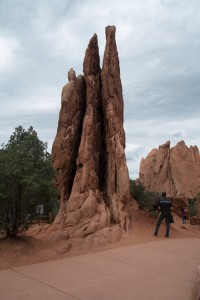One of my treasured memories of college thirty-plus years ago is the mornings spent in Bob Carson’s geology classes learning the physiographic provinces of the North American continent. It was a beautiful slide show combined with a deeply meaningful (to me) new set of organizing principles for looking at the landscape around me. I wasn’t becoming a scientist, but instead was learning an incredibly rich new way of looking at the world.
The text we used, which remains on my shelf today, captures the premise: “Natural Regions of the United States”. Here was a way of organizing the landscape that made sense on the landscape’s own terms, not in terms of things we humans had come along and done later. And so it was that I ended up over the last few days driving to Colorado and back along I-25 on the boundary of two of those great “natural regions” – the Colorado Piedmont and Raton Section of the Great Plains Province and the Southern Rocky Mountains. I carry with me now my own conceptual labels instead, and driving up to Colorado Springs Sunday I kept casting my eyes back and forth between the Great Flat Part to my right and the Great Sticky Up Bits to my left.
The interstate is never far from the seam between the two, and often runs right on top of it. But the funnest expression was when my host Eric Perramond at Colorado College (thanks, Eric!) took me for an afternoon drive up to Garden of the Gods, a delightful Colorado Springs city park in the foothills where you can literally walk through the seam’s stitching. To the west, the Great Sticky Up Bits, pushed up by the Laramide Orogeny, shoved overlying sedimentary rocks out of the way as they rose. Garden of the Gods is the resulting debris, an impossibly beautiful collection of sandstone slabs tipped up on end with lovely walking trails among them and a big parking lot for all the humans such as Eric and me to ogle the nice continental stitching.
To the north, Eric pointed me to the long way ’round Denver up 470 toward Boulder, where highways and neighborhoods and river channels zig and zag through the stitching, until you get to Boulder’s Flatirons. This is all complicated by the hydrologic system draped atop things which is what usually distracts me. But the entire way, from Las Vegas, NM, all the way to Denver and Boulder, you’re never far from the fundamental boundary between Great Flat Part and Great Sticky Up Bits, the two great Natural Regions in physical display.


That’s cool, thanks John.
Best,
D